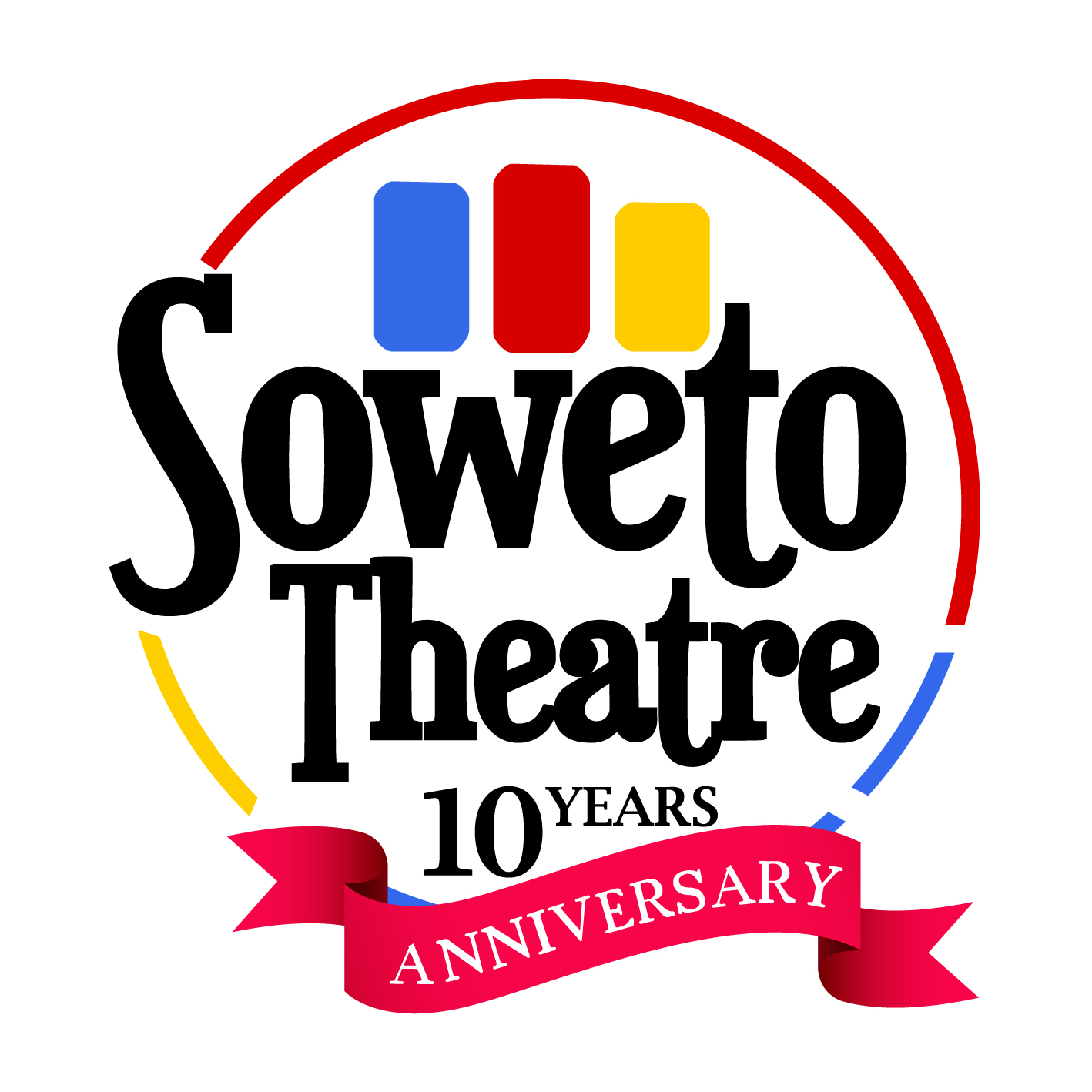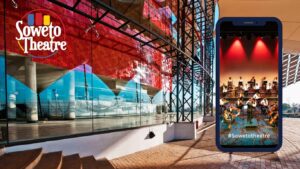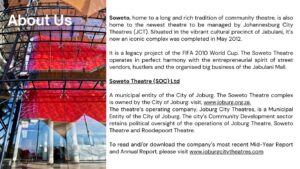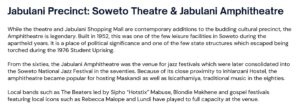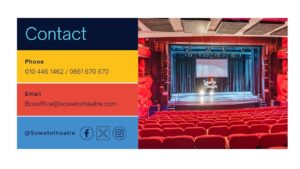THE JOBURG THEATRE UMBRELLA
The Soweto Theatre Arrives on the Scene
One of the major South African legacy projects linked to the 2010 World Cup was the construction of the first fully equipped, professional theatre facility in the vast township of Soweto, an area now administratively merged with Johannesburg. This showpiece project was to be built near a major shopping centre and adjacent to a large outdoor amphitheatre in Soweto’s Jabulani neighbourhood. (The nation’s infrastructure building effort in tandem with the World Cup also included the new Gautrain system — dedicated rapid rail lines to link downtown Johannesburg, Sandton, Pretoria and the region’s international airport, as well as major sports venues in Johannesburg and elsewhere.)
Until construction of the Soweto Theatre, live drama and musical productions in Soweto — the country’s largest and most historic township — had needed to use school, church, or community halls, none of which were technically equipped for professional theatre work. While the Jabulani Amphitheatre had been in use since 1952 and it had hosted memorable live music shows over its history, the city’s plan for the future envisioned bringing the amphitheatre up to modern technical standards for professional outdoor performances. The nearby mall was one of Soweto’s major shopping areas constructed in the post-1994 years, and in a township with no real CBD core, urban planners believed this growing concentration of facilities could spur development of a modern downtown for the township.
Steven Sack, a veteran arts and culture administrator at both city and national levels and experienced as a community arts manager as well, was appointed to shepherd the actual creation of the Soweto Theatre. As part of that, he was given a temporary assignment to head the city’s other theatrical facility, the Pro Musica, now renamed the Roodepoort Theatre, located on the West Rand. This theatre would, at least initially, take administrative responsibility for the new Soweto Theatre as it began to come on stream. The Roodepoort Theatre had been established in 1981 by the independent city of Roodepoort — but it later became the responsibility of the City of Johannesburg once Roodepoort was merged into Johannesburg’s post-1994 metropolitan government.
The Roodepoort Theatre, in its early years, had built a reputation as a home for classical orchestral and chamber concerts, as well as staged operas, for audiences from among the West Rand mining communities and the suburbs beyond them. Over the years, it had hosted numerous highly regarded international musicians such as violinist Nigel Kennedy, cellist Mischa Maisky, and singer Elly Ameling, and, more recently, major South African talents such as singer Sibongile Khumalo. By 2008, however, its production units had been closed in response to financial pressures, and its management then focused on the receiving house model instead.
As the theatre described its efforts in its reports, it explained that it had “made major progress in terms of the diversification of its production and marketing mix, which consequently had a significant impact on the diversification of audiences. However because its venues are relatively small in capacity, the Roodepoort Theatre was not always in a position to attract sufficient artistic products to keep the stages occupied. As a result, the Theatre acted as a producing house, and staged work in a diverse range of genres, including music and musical theatre, comedy, and children’s theatre. In addition, the Theatre played a significant developmental role by means of providing a venue for community theatre initiatives in the area, as well as running tuition programmes that provided instrumental, vocal, dance and drama tuition for students from
disadvantaged backgrounds.”
By the time Sack was beginning to think through a model for the new theatre in Soweto, he and a select group of city administrators and advisors travelled to various well-established commercial and government theatres in South Africa, as well as several in foreign locations for insights about what the organisational structure and uses of the theatre should be. Together with the city’s property company, Sack and his colleagues then looked at various sites designated for cultural use in the urban planning documents for Soweto. In the end, land owned by the city was picked as the site for the Soweto Theatre.
While construction of this new development was moving forward, the city was also moving forward with plans to merge the administration of the Roodepoort Theatre with its now-corporatised Joburg Theatre. After much discussion about managerial arrangements for the new Soweto Theatre once it was built, the city determined this newest theatre would also be combined together with the Joburg and Roodepoort Theatres, even though it was initially to be developed under the wing of the Roodepoort Theatre. Through this merger, city administrators were acting on the belief real administrative cost savings were possible from such an arrangement, especially once the three facilities had one combined board and a unified senior administrative leadership. There was also the sense this merger could unleash creative synergies from the possibilities of the combined entities.
The major impetus for a Soweto Theatre had been a pledge from Johannesburg mayor Amos Masondo. He had been a particularly strong proponent of the idea, and he linked that dream to the infrastructure programs being rolled out in the run-up to the World Cup.
Mayor Masondo believed strongly that Soweto deserved its own theatre, and that its construction would be a tangible legacy from his tenure as mayor. Individuals who worked with him during his time as mayor have said the he was an active enthusiast for the city’s cultural life, including theatre, believing it could be an important element in building a transformed city. As he had said, as the Soweto Theatre was under construction, “We are striving to change Soweto into a sustainable human settlement that is known not just as a place where people come from but where people also go to.”
Back in 2012, the Joburg Theatre’s council elaborated on this dream saying the “Soweto Theatre initiative is aimed at redressing decades of cultural and social infrastructure neglect. The facility is intended as a vibrant, active and exciting multi-purpose cultural venue, contributing to the transformation of Johannesburg into ‘a world-class African city.’ The venue will host festivals, conferences, meetings and community gatherings and the Theatre aims to attract and develop new audiences. The precinct is also intended to facilitate the development of diversified revenue streams to augment the economy of Soweto.”
These objectives had been formulated in connection with the city’s larger “2040 Growth and Development Strategy.” As acting CEO for the Roodepoort Theatre, Sack had written that the key opportunities arising from the new theatre included the themes of creating a “smart city” while dealing effectively with youth and diversity. The emerging interventions needed to include efforts to support and grow competitive creative industry, transforming deprived spaces, institutional development and financial sustainability.
Construction of the new theatre followed an innovative design from the architectural firm, Afritect. Some people affectionately continue to refer to the resulting building as looking like a set of “giant Lego blocks,” a reaction to its very distinctive shape and the bright colours of red, blue and yellow on the structure’s exterior, referencing the three venues within the building.
The winning design offered those three separate performing venues, set with varied seating capacities scaled for the needs of various events. The building would also incorporate space for outdoor events on the lip extending out from the building, and eventually the theatre would connect with the renovated Jabulani Amphitheatre nearby.
When it was completed in 2012, the Soweto Theatre became the first professionally outfitted theatre in any of South Africa’s black townships. The glittering opening ceremony included a commissioned verse work recited by Mzwakhe Mbuli, “The People’s Poet.” in honour of the building’s opening. In his words, Mbuli paid tribute to the forebears of black, liberation, and struggle theatre from Soweto who had been among the country’s important cultural figures, or who were also closely associated with the township’s cultural life. The opening night crowd then proceeded inside to watch a production of “The Suitcase,” a play adapted by director James Ngcobo from Es’kia Mphahlele’s poignant short story about the disastrous consequences that flowed from a single, tragic misjudgement.
An inaugural theatre season then continued over succeeding weeks, along with other activities. After the opening, however, there was still the complicated administrative and legal work required to conclude the complex administrative and legal amalgamation of the three theatres — the Joburg Theatre and the Roodepoort Theatre, with the new Soweto Theatre now in the mix as well.
In explaining the choice of “The Suitcase” for the Soweto Theatre’s opening, James Ngcobo, artistic director of the Market Theatre, explained that city officials had determined that the first play in the new theatre should be a serious drama, rather than a “happy, flighty” party entertainment and the playwright, after all, was one of Soweto’s most famous literary sons. For the rest of the opening season, Ngcobo directed two other modern South African classics. One was “Bopha” by Percy Mtwa, and the other was Athol Fugard’s “Nongogo.” (Several years later, in another exciting cross-fertilisation, Ngcobo had brought leading actress Sandra Prinsloo and her searing drama, “Kamphoer,” to the Roodepoort Theatre, following its run at the Market Theatre that had followed its first performances at Cape Town’s Baxter Theatre.)
BOARD OF DIRECTORS
The following were elected to the Board of Directors at the AGM held on 1 March 2023:
Godfrey Katsana – Chairperson
Thapelo Chokobane
Bonga Kweyama
Delisiwe Mabena
Johanna Mapeko
Thembinkosi Mbeda
Ziyanda Mncanca
Ben Mothupi
Pamela Ndlovu
Orapeleng Ramagaga
Sbusiso Francisco Xaba
Vukani Magubane (CFO)
Xoliswa Nduneni-Ngema (CEO)
